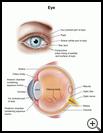
Uveitis
________________________________________________________________________
KEY POINTS
- Uveitis is swelling and irritation of all or part of the uvea, which is the inner layer of your eye.
- Treatment depends on the cause. Inflammation and infection can be treated with eye drops or medicines that you take by mouth. When uveitis is related to a problem that affects other parts of your body, that problem must be treated in order to treat your eye.
________________________________________________________________________
What is uveitis?
Uveitis is swelling and irritation of all or part of the uvea, which is the inner layer of your eye.
Inflammation can affect any or all of these parts. If uveitis is not treated or if it is treated and then comes back, it can cause more problems, such as cataracts, glaucoma, swelling of the retina (known as macular edema), or retinal detachment. These problems can cause blindness.
What is the cause?
The exact cause of uveitis is not known. It may be caused when your body’s immune system attacks the tissue inside your eye. Possible causes include:
- Immune system problems, such as rheumatoid arthritis, lupus, and sarcoidosis
- Infections, such as chickenpox, herpes, Lyme disease, and syphilis
What are the symptoms?
Uveitis that involves the front part of the eye has the following symptoms:
- Painful sensitivity to light
- Redness
- Deep or dull aching pain
- Reduced vision
These symptoms may happen in just one eye. They tend to appear suddenly and worsen quickly.
When the middle or back part of the eye is affected, the only symptom may be problems with your vision. You may see an increase in floaters, which are dark spots or threads in your field of vision. This may happen in both eyes, but one eye may be worse than the other.
How is it diagnosed?
Your eye care provider will ask about your symptoms and medical history and do exams and tests such as:
- An exam using a microscope with a light attached, called a slit lamp, to look closely at the front and back of your eye
- An exam using drops to enlarge, or dilate, your pupils and a light to look into the back of your eyes. Photographs may be taken to show irritation or swelling in the retina.
- Blood tests to check for signs of infection
How is it treated?
Treatment of uveitis depends on the cause. Inflammation and infection can be treated with eye drops or medicines that you take by mouth. Both uveitis and some of the medicines used to treat it can cause cataracts or high eye pressure. Your provider will check your progress closely. As the inflammation is brought under control, your provider will have you slowly stop using the medicines. It is very important to follow your provider’s instructions closely. A sudden decrease in these medicines can cause the inflammation to come back.
When uveitis is related to a problem that affects other parts of your body, that problem must be treated in order to treat the inflammation in your eye.
How can I take care of myself?
Follow the full course of treatment your healthcare provider prescribes. Ask your healthcare provider:
- How and when you will get your test results
- How long it will take to recover
- If there are activities you should avoid and when you can return to your normal activities
- How to take care of yourself at home
- What symptoms or problems you should watch for and what to do if you have them
Make sure you know when you should come back for a checkup. Keep all appointments for provider visits or tests.
How can I help prevent uveitis?
Because the cause is usually not known, most cases cannot be prevented.

